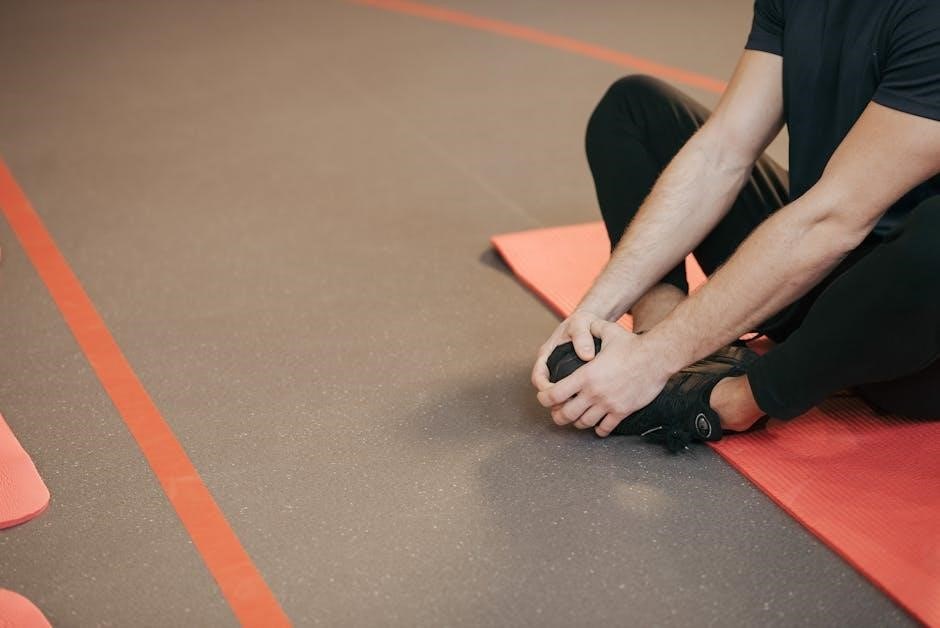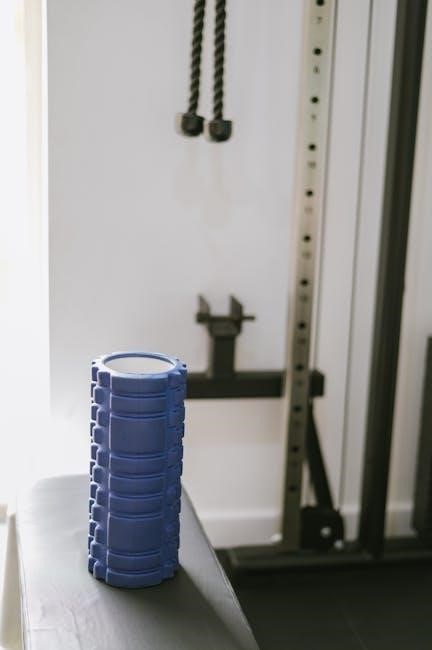The piriformis muscle is a flat, pear-shaped muscle located in the gluteal region, playing a crucial role in hip rotation and stabilizing the pelvis during movement․
Originating from the base of the spine, it attaches to the thighbone, functioning as a key lateral rotator and contributor to hip joint mobility and stability․
Overview of the Piriformis Muscle
The piriformis muscle is a flat, pear-shaped muscle located in the gluteal region, belonging to the deep gluteal muscles․ It is the most superficial muscle in this group and plays a key role in hip movement as part of the lateral rotators․ Originating from the anterior surface of the sacrum, it inserts on the greater trochanter of the femur․ Its primary functions include external rotation of the hip, assisting in extension, and stabilizing the hip joint during walking․ Additionally, it helps in maintaining pelvic balance and is active during various daily activities like sitting and standing․ Tightness or spasm in the piriformis muscle can lead to piriformis syndrome, causing sciatic nerve compression and resulting in pain and discomfort․ Understanding the structure and function of this muscle is essential for effective stretching and strengthening exercises aimed at preventing and managing such conditions․
Location and Function of the Piriformis Muscle
The piriformis muscle is located in the gluteal region, deep beneath the gluteus maximus and above the gluteus medius․ It is a flat, pear-shaped muscle that belongs to the deep gluteal muscles, which are part of the lateral rotators of the hip․ This muscle originates from the anterior surface of the sacrum and inserts on the greater trochanter of the femur․ Its primary function is to externally rotate the hip joint, stabilizing the pelvis during activities like walking or running․ Additionally, it assists in hip extension and helps maintain balance by controlling excessive internal rotation of the hip․ The piriformis muscle plays a vital role in maintaining proper hip mechanics and is essential for movements that require stability and precision․
Importance of the Piriformis Muscle in Hip Movement
The piriformis muscle plays a critical role in hip movement by enabling external rotation and stabilizing the pelvis during dynamic activities․ It prevents excessive internal rotation of the hip, which could lead to poor biomechanics and potential injuries․ This muscle is essential for maintaining proper alignment and balance, particularly during walking, running, or climbing stairs․ Its ability to stabilize the hip joint ensures smooth and efficient movement, making it indispensable for everyday activities and athletic performance․ Without proper function of the piriformis muscle, individuals may experience difficulty in maintaining balance or performing movements that require precision and control․ Thus, its role in hip movement is vital for overall mobility and lower limb mechanics․

Piriformis Syndrome
Piriformis syndrome is a neuromuscular condition where the piriformis muscle compresses the sciatic nerve, leading to pain, tingling, and discomfort in the buttocks and legs․
What is Piriformis Syndrome?
Piriformis syndrome is a condition where the piriformis muscle irritates the sciatic nerve, causing pain in the buttocks and legs․ Located deep in the buttocks, the piriformis muscle is one of the lateral rotators of the hip, aiding in outward leg rotation․ When this muscle becomes tight or inflamed, it compresses the sciatic nerve, leading to symptoms like sharp pain, numbness, or tingling․ Activities such as prolonged sitting can exacerbate symptoms, as pressure on the muscle increases․ Piriformis syndrome is often mistaken for sciatica but is specifically related to muscle-related nerve compression․ It is a common cause of buttock pain and can be challenging to diagnose due to overlapping symptoms with other conditions․
Symptoms of Piriformis Syndrome
Piriformis syndrome typically presents with sharp pain or discomfort in the buttocks, often radiating down the back of the leg due to sciatic nerve irritation․ Numbness or tingling sensations may also occur in the affected areas․ Pain usually intensifies during activities such as sitting for long periods, walking, or climbing stairs․ Some individuals experience tenderness when pressing directly on the buttock region․ Stretching the piriformis muscle can temporarily relieve symptoms but may also trigger discomfort in certain positions․ The pain can vary in severity, ranging from mild discomfort to debilitating episodes․ It’s important to note that symptoms may mimic other conditions, such as sciatica, making accurate diagnosis essential․ Early recognition of these symptoms can lead to timely interventions, preventing prolonged discomfort and improving quality of life․
Causes of Piriformis Syndrome
Piriformis syndrome occurs when the piriformis muscle compresses or irritates the sciatic nerve, often due to muscle tightness or spasm․ Common causes include prolonged sitting, especially on hard surfaces, improper lifting techniques, and repetitive movements that strain the muscle․ Muscle imbalances, such as weak abdominal muscles or tight hip flexors, can also contribute․ Overuse from activities like running or cycling may lead to inflammation and irritation․ Additionally, anatomical variations, such as a larger piriformis muscle or nerve abnormalities, can predispose individuals to the condition․ In some cases, trauma or direct pressure on the buttocks may trigger symptoms․ Addressing these underlying factors is key to managing and preventing piriformis syndrome․
Diagnosis of Piriformis Syndrome
Diagnosing piriformis syndrome can be challenging, as there is no single definitive test․ It is often identified through a combination of clinical evaluation, patient history, and physical examination․ Symptoms such as pain in the buttocks that worsens with sitting, radiating pain down the leg, and tenderness in the affected area are key indicators․ Physical tests, like the Pace test or Freiberg test, may be used to assess muscle tightness and nerve irritation․ Imaging studies, such as MRI, can help rule out other causes of sciatica, like herniated discs, but cannot confirm piriformis syndrome directly․ A diagnosis is typically made after excluding other conditions and identifying characteristic symptoms and physical findings․
Treatment Options for Piriformis Syndrome
Treatment for piriformis syndrome focuses on relieving muscle tension and reducing sciatic nerve compression․ Conservative approaches include physical therapy, stretching exercises, and ice therapy to alleviate pain and inflammation․ Anti-inflammatory medications or muscle relaxants may be prescribed to manage symptoms․ In some cases, corticosteroid injections are used to reduce swelling․ Gentle exercises, such as piriformis stretches and yoga, can help improve flexibility and strength․ For severe cases, surgical intervention may be considered to release the muscle and nerve compression․ A tailored treatment plan, often combining these methods, is typically recommended to address individual needs and promote long-term recovery․

Stretches for the Piriformis Muscle
Stretches target the piriformis muscle to relieve tension and improve hip mobility, offering various exercises like seated, standing, and dynamic stretches for optimal muscle relief․
Basic Piriformis Stretches
Basic piriformis stretches are essential for relieving muscle tension and improving flexibility․ One common stretch involves lying on your back, crossing the affected leg over the other knee, and gently pulling the unaffected leg toward your chest until a stretch is felt in the buttock․ Another simple stretch is the seated piriformis stretch, where you sit with the affected leg crossed over the other thigh, placing your hand on the knee of the crossed leg and applying gentle pressure to deepen the stretch․ These exercises target the piriformis muscle, helping to reduce tightness and discomfort․ Regular practice can improve hip mobility and alleviate symptoms associated with piriformis syndrome․ Always hold stretches for 20-30 seconds and repeat 2-3 times for optimal results․
Advanced Piriformis Stretches
Advanced piriformis stretches are designed for individuals with greater flexibility and those seeking deeper relief from tightness or piriformis syndrome․ One effective stretch is the pigeon pose, performed on the floor by bringing one knee forward and extending the other leg behind, applying gentle pressure to the hip of the forward leg․ Another advanced stretch involves standing and crossing one ankle over the opposite knee, then bending forward to intensify the stretch in the buttock․ Additionally, side-lying stretches, where you lie on one side and bring the top leg back toward your shoulder, can target the piriformis deeply․ These stretches require proper alignment and breathing techniques to maximize effectiveness and avoid discomfort․ Regular practice of these advanced stretches can significantly enhance hip mobility and reduce muscle tension․ Consistency is key for long-term relief․
Yoga-Based Stretches for the Piriformis
Yoga-based stretches are highly effective for targeting the piriformis muscle, offering relief from tension and improving hip flexibility․ The pigeon pose is a popular yoga stretch that deeply engages the piriformis, mimicking the motion of a pigeon’s stride․ To perform it, start on all fours, bring one knee forward, and extend the other leg behind, lowering your torso to the ground while keeping your chest upright․ Another beneficial pose is the seated figure-four stretch, where you cross one ankle over the opposite knee and gently press down on the knee to deepen the stretch․ Additionally, the downward-facing dog pose can be modified to target the piriformis by bending one knee and extending the other, stretching the back leg․ These yoga-based stretches promote relaxation of the piriformis muscle and enhance overall hip mobility when practiced consistently․
Dynamic Stretches for the Piriformis
Dynamic stretches for the piriformis involve controlled movements that warm up and loosen the muscle, improving flexibility and reducing tension․ One effective stretch is the side-lying piriformis stretch: lie on your side with knees bent, cross the affected leg over the other, and gently press down on the knee to feel a stretch in the buttock․ Another option is the standing lunge twist, where you step forward into a lunge position and twist your torso to deepen the stretch in the piriformis․ Additionally, the glute kickback march combines movement with stretching by bending at the hips and marching in place while engaging the glutes․ These dynamic stretches are ideal for pre-workout routines or as part of active recovery to maintain piriformis mobility and prevent stiffness․
Seated Stretches for the Piriformis
Seated stretches for the piriformis are ideal for targeting the muscle while maintaining proper posture and minimizing strain on other areas․ One effective stretch is the seated piriformis stretch: sit with your affected leg crossed over your thigh, place your hand on the knee of the crossed leg, and gently pull it toward your opposite shoulder until a stretch is felt in the buttock․ Hold for 20-30 seconds and repeat 2-3 times․ Another option is the seated figure-four stretch, where you place your ankle on the opposite knee, lean forward slightly, and apply gentle pressure to deepen the stretch․ These stretches are particularly beneficial for individuals who spend prolonged periods sitting, as they help alleviate tightness and improve circulation to the piriformis muscle․

Exercises for Piriformis Muscle Relief
Exercises for piriformis muscle relief include strengthening, flexibility, and core workouts․ These help reduce tension, improve mobility, and prevent sciatic nerve irritation, promoting hip health․
Strengthening Exercises for the Piriformis
Strengthening the piriformis muscle is essential for improving hip stability and reducing pain․ Clamshell exercises, side-lying abductions, and donkey kicks target the piriformis effectively․ These exercises help restore muscle balance and prevent sciatic nerve irritation․ Perform them with controlled movements to avoid overstretching․ Strengthening the piriformis enhances hip rotation and pelvic stability, which are vital for proper gait and posture․ Incorporate these exercises into your routine to alleviate piriformis-related discomfort and improve overall hip function․ Consistency is key to achieving long-term relief and muscle strength․
Flexibility Exercises for the Piriformis
Improving piriformis flexibility is crucial for relieving tightness and sciatic nerve compression․ Seated stretches, pigeon pose, and supine piriformis stretches are effective for enhancing muscle elasticity․ Perform these stretches gently to avoid muscle strain․ Holding each stretch for 20-30 seconds ensures optimal relaxation of the tissue․ Regular stretching improves hip mobility and reduces muscle tension, which can alleviate piriformis syndrome symptoms․ Incorporate these exercises into your daily routine to maintain flexibility and prevent muscle imbalances․ Consistent practice promotes long-term relief and enhances overall hip joint health, reducing the risk of future discomfort and improving range of motion․ These exercises are simple yet highly beneficial for piriformis muscle care․
Core Strengthening Exercises for Piriformis Health
Strengthening the core muscles plays a vital role in supporting the piriformis and maintaining proper hip alignment․ Planks, bird-dog exercises, and pelvic tilts are excellent for enhancing core stability․ These exercises improve posture, reduce muscle imbalances, and alleviate piriformis-related discomfort․ Incorporate activities like bridges and side planks to target the glutes and lower back, which work synergistically with the piriformis․ Strengthening the transverse abdominis through exercises like draw-ins can help stabilize the pelvis, reducing strain on the piriformis․ Regular core workouts promote overall hip and lower back health, preventing muscle tightness and improving movement efficiency․ A strong core provides a solid foundation for the piriformis to function optimally, reducing the risk of injury and enhancing mobility․

Lifestyle Changes for Piriformis Health
Avoid prolonged sitting, maintain proper posture, and manage weight to reduce strain on the piriformis muscle, promoting overall hip and lower back well-being․
Postural Adjustments for Piriformis Relief
Maintaining proper posture is essential for piriformis health․ Avoid slouching or leaning forward, as this can strain the muscle․ When sitting, ensure your chair supports your lower back, and keep your knees at hip level․ Sleeping on your side with a pillow between your knees can reduce pressure on the piriformis․ Avoid crossing your legs or sitting for extended periods, as this can tighten the muscle․ Regularly standing up and stretching can help prevent prolonged tension․ Strengthening core muscles and improving overall posture can reduce strain on the piriformis, promoting long-term relief and preventing discomfort․
Workplace Ergonomics for Piriformis Health
Proper workplace ergonomics is crucial for maintaining piriformis health and preventing strain․ Ensure your chair height allows your feet to rest flat on the floor or a footrest, with knees at hip level․ A lumbar support cushion can help maintain the natural curve of your spine․ Position your desk and computer to avoid leaning forward or twisting, which can tighten the piriformis muscle․ Avoid sitting for long periods without movement; take regular breaks to stand and stretch․ Additionally, keep frequently used items within easy reach to minimize repetitive stretching or bending․ Implementing these ergonomic adjustments can significantly reduce piriformis tension and promote overall hip and lower back well-being․
Dietary Changes to Reduce Piriformis Inflammation
To reduce inflammation and alleviate piriformis muscle tension, incorporating anti-inflammatory foods into your diet is essential․ Focus on consuming omega-3 rich foods like fatty fish (salmon, mackerel), flaxseeds, and walnuts, which help reduce inflammation․ Increase your intake of antioxidants found in berries, leafy greens, and other fruits and vegetables․ Whole grains, such as brown rice and quinoa, provide sustained energy and anti-inflammatory properties․ Stay hydrated with water and herbal teas to maintain muscle flexibility․ Avoid processed foods, sugary snacks, and excessive alcohol, as they can exacerbate inflammation․ Including turmeric and ginger in meals can also help combat inflammation naturally․ A balanced diet, combined with regular stretching, can significantly support piriformis health and overall well-being․

When to See a Professional
Consult a healthcare professional if piriformis-related pain persists, worsens, or interferes with daily activities, as specialized treatments or physical therapy may be necessary․
Signs You Need Medical Attention for Piriformis Issues
If pain persists despite self-care, or if numbness, tingling, or weakness occurs, seek medical attention․ Severe or radiating pain, especially down the leg, may indicate nerve compression․

A professional should be consulted for chronic symptoms, as delayed treatment could worsen the condition․ Proper diagnosis and interventions are essential for effective recovery and prevention of long-term issues․
Physical Therapy for Piriformis Syndrome
Physical therapy is a cornerstone in managing piriformis syndrome, focusing on relieving muscle tension and improving mobility․ A qualified therapist may use techniques like soft tissue mobilization and joint mobilization to reduce muscle tightness and restore normal movement patterns․ They often prescribe targeted exercises to strengthen the surrounding muscles and enhance flexibility․ Additionally, therapists may incorporate modalities such as heat or ultrasound to alleviate pain and inflammation․ Patient education on proper posture, ergonomics, and stretching routines is also a key component․ By addressing both the symptoms and underlying causes, physical therapy can effectively reduce discomfort and prevent future episodes, helping individuals regain optimal hip and pelvic function․
Medical Treatments for Persistent Piriformis Pain
For persistent piriformis pain that does not respond to conservative treatments, medical interventions may be necessary․ Corticosteroid injections are commonly used to reduce inflammation and alleviate pain when the muscle compresses the sciatic nerve․ In some cases, local anesthetic injections may also be administered to relax the muscle and interrupt pain signals․ Oral medications such as nonsteroidal anti-inflammatory drugs (NSAIDs) or muscle relaxants can help manage symptoms․ In severe cases, botulinum toxin injections have been explored to relax the piriformis muscle․ Surgery is typically considered a last resort and may involve releasing the piriformis muscle or addressing nerve compression․ These treatments are usually recommended after a thorough evaluation by a healthcare professional to ensure they are appropriate for the patient’s condition․
Proper management of the piriformis muscle through stretches, exercises, and medical treatments ensures long-term relief and hip health, preventing future complications and enhancing overall mobility and well-being․
Effective management of the piriformis muscle involves a combination of targeted stretches and lifestyle adjustments to maintain hip mobility and reduce discomfort․ Key stretches include the seated piriformis stretch, pigeon pose, and dynamic movements to improve flexibility․ Regular practice of these exercises can alleviate tightness and prevent muscle strain․ Additionally, incorporating core-strengthening exercises supports overall pelvic stability․ Proper posture, ergonomic adjustments, and avoiding prolonged sitting are essential for long-term care․ By consistently practicing these routines, individuals can enhance muscle function, reduce inflammation, and prevent piriformis-related pain, ensuring optimal hip and lower body health․
Long-Term Management of Piriformis Health
Long-term management of piriformis health requires a consistent and holistic approach to maintain muscle flexibility, strength, and overall pelvic stability․ Incorporating daily stretching routines, such as seated stretches and dynamic movements, helps prevent tightness and discomfort․ Strengthening exercises for the core and hip muscles also play a crucial role in supporting the piriformis and reducing strain․ Proper posture, ergonomic adjustments, and avoiding prolonged sitting are essential lifestyle modifications․ Additionally, maintaining a healthy weight and adopting anti-inflammatory dietary habits can reduce muscle irritation․ Regular physical activity, such as walking or swimming, promotes circulation and muscle relaxation․ By combining these strategies, individuals can effectively manage piriformis health and prevent future issues, ensuring long-term comfort and mobility․

Additional Resources
Downloadable PDF guides provide detailed stretches and exercises for piriformis relief․ Visit health websites or fitness platforms for these resources․ Explore recommended reading for further insights․
PDF Guides for Piriformis Stretches
PDF guides offer comprehensive routines targeting the piriformis muscle, with detailed diagrams and step-by-step instructions for stretches like the seated figure-four and pigeon pose․
These guides often include dynamic and yoga-based stretches, providing a holistic approach to muscle relief and flexibility․ They are accessible online, catering to both beginners and advanced users․
Many guides emphasize proper form and breathing techniques to maximize benefits and prevent injury․ They are ideal for self-guided therapy or as a complement to professional treatment plans․
By incorporating these exercises, individuals can effectively manage piriformis-related discomfort and enhance overall hip mobility, promoting long-term muscle health and well-being․
Recommended Reading on Piriformis Syndrome
For those seeking in-depth understanding, various resources provide comprehensive insights into piriformis syndrome, including its symptoms, causes, and treatment options․
Online guides and medical journals offer detailed explanations, while books on musculoskeletal health delve into the anatomy and function of the piriformis muscle․
These materials often include case studies, expert opinions, and patient testimonials, offering a well-rounded perspective on managing the condition․
Additionally, downloadable PDFs and e-books focus on exercises, stretches, and lifestyle adjustments to alleviate symptoms and improve muscle flexibility․
Whether you’re a patient or a practitioner, these resources serve as valuable tools for education and effective management of piriformis syndrome․
